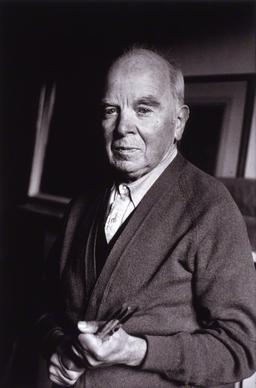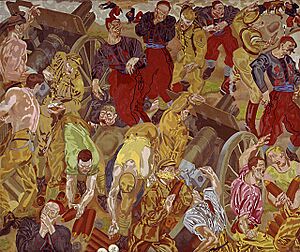William Roberts (painter) facts for kids
Quick facts for kids
William Roberts
|
|
|---|---|

William Roberts (1970)
|
|
| Born |
William Patrick Roberts
5 June 1895 Hackney, London, England
|
| Died | 20 January 1980 (aged 84) |
| Education |
|
| Known for | Painting |
William Patrick Roberts (born June 5, 1895 – died January 20, 1980) was an important British artist. He was known for his unique painting style.
Before the First World War, Roberts was one of the first English artists to use abstract images. Later, he called his style "English Cubist." During the First World War, he served as a gunner. In 1918, he became an official war artist.
Roberts had his first art show in London in 1923. Many of his paintings were bought for galleries across the UK. In the 1930s, he was at his artistic best. Even though his art was shown often, he always struggled with money. This continued during the Second World War, even when he worked as a war artist.
Roberts is best known for his large, colorful paintings. He showed these every year at the Royal Academy from the 1950s until he died. He had a big art show at the Tate Gallery in 1965. He became a full member of the Royal Academy in 1966. Recently, people have become more interested in his art again.
Contents
William Roberts: Early Life
Roberts was born on June 5, 1895, in London's East End. His family lived in Hackney, and his father was a carpenter. From a young age, William was very good at drawing. His parents and teachers encouraged him.
At 14, Roberts left school. He started an apprenticeship at an advertising company. He wanted to become a poster designer. He also took evening classes at Saint Martin's School of Art. He won a scholarship to the Slade School of Art. This meant he didn't have to continue his apprenticeship.
He joined the Slade in 1911. He studied under famous teachers like Henry Tonks. Other talented students there included Stanley Spencer and David Bomberg. The Slade taught him how important drawing and good composition were. These skills helped him throughout his career. In 1912, he won a prize for his figure composition.
An English Cubist Style
Roberts was very interested in Post-Impressionism and Cubism. He learned more about these styles from his friends at the Slade. He also traveled in France and Italy after leaving art school in 1913.
In 1913, he joined Roger Fry's Omega Workshops. This work helped him create challenging Cubist-style paintings. One example is The Return of Ulysses. After Omega, he worked with Wyndham Lewis. Lewis was creating a British art movement called Vorticism.
Roberts's art was shown in BLAST, a Vorticist magazine. He also signed the Vorticist Manifesto. However, Roberts himself preferred to call his work from this time "Cubist." His paintings like The Toe Dancer and Boxers show his bold Cubist style.
A War Artist
In 1916, Roberts joined the Royal Regiment of Artillery. He served as a gunner on the Western Front. He was in areas like Ypres and Arras. After almost two years of service, he applied to become a war artist.
In April 1918, he returned to London as an official war artist. He was asked not to use his Cubist style for these works. His painting The First German Gas Attack at Ypres is a powerful work. It is now on display in the Canadian War Museum in Ottawa.
The British Ministry of Information also hired him. He painted A Shell Dump, France (1918–19). This painting is now in the Imperial War Museum. He also made twelve watercolor drawings of his war experiences. These drawings show the harsh reality of war. In 1978, Roberts wrote a book about his time in the war. It was called 4.5 Howitzer Gunner RFA.
The 1920s: New Beginnings
Roberts met Sarah Kramer in 1915. She was the sister of his friend, Jacob Kramer. William and Sarah started living together after the war. They had a son, John David Roberts, in 1919. They got married in 1922.
Roberts was also a talented portrait painter. He often painted Sarah, who was his model for 60 years. In 1923, he was preparing for a show in London. He was asked by T. E. Lawrence to create portraits for his book Seven Pillars of Wisdom.
Roberts developed his own unique "English Cubist" style. He started painting scenes of city life in London. Examples include Bank Holiday in the Park and At the Hippodrome. His painting The Cinema was bought by the Tate Gallery. He also painted scenes from Greek and Christian stories.
The Contemporary Art Society bought many of his paintings. This helped Roberts financially. From 1925, he also taught art one day a week at the Central School of Art. He kept this job until 1960. Towards the end of the 1920s, his work became lighter. Paintings like The Tea Garden (1928) and The Chess Players (1929) showed social scenes. They fit well with the popular Art Deco style of the time.
The 1930s: A Softer Style
In the 1930s, Roberts's art changed. His sharp, angular style became softer and more rounded. You can see this in his portrait of John Maynard Keynes and Lydia Lopokova. This painting is in the National Portrait Gallery, London.
Keynes became an important supporter of Roberts. He bought many paintings that are now at King's College, Cambridge. Roberts said the 1930s were "years of economic struggle." But he still created large, striking paintings. These included The Masks (1934) and The Playground (The Gutter) (1934–5). These were shown in Pittsburgh and New York.
Despite money problems, the family sometimes took holidays. They went to Spain in the early 1930s. A cycling trip to Brighton inspired his painting Les Routiers. Some art experts think he used a French title to connect with the artist Fernand Léger. Léger's "tubist" figures were similar to Roberts's rounded shapes.
The 1940s: War and Return to London
When the Second World War started in 1939, William and Sarah moved to Oxford. Roberts was too old to fight. He wanted to do art for the war effort. He was disappointed to get only small jobs for the War Artists' Advisory Committee.
However, he did complete two commissions about life on the home front. These were Munitions Factory (1940) and The Control Room, Civil Defence Headquarters(1942). Both are now in Salford Art Gallery. The Roberts family spent most of the war in Oxford. William also taught art one day a week at Oxford Technical College. He often drew inspiration from his surroundings. Many of his watercolors from this time show rural scenes.
In 1946, he and Sarah returned to London. They found a room in a house near Primrose Hill. They eventually bought the whole house. This house became their home for the rest of their lives. The neighborhood gave Roberts many ideas for his art. Their son, John, who studied physics, joined them.
In 1948, Roberts showed his art at the Royal Academy summer exhibition for the first time. He showed a self-portrait and a portrait of Sarah. He continued to show his work there every year until he died.
The Royal Academy and "Vortex Pamphlets"
In the 1950s, abstract art was very popular in Britain. Roberts's art, which was more representational, seemed old-fashioned. He saw the Royal Academy as a good place to show his work. It attracted many people who liked traditional art.
From this time on, Roberts's yearly contributions became more dramatic. His paintings were large, colorful, and had exciting subjects. The Temptation of St Anthony (1951) and The Birth of Venus (1954) were big talking points. Roberts found a new supporter, Ernest Cooper. Cooper bought many of his Royal Academy paintings. He also asked Roberts to create illustrations for his health-food catalogs.
In 1956, the Tate Gallery held an exhibition about Wyndham Lewis and Vorticism. Roberts felt the show made him seem less important than Lewis. He published a series of "Vortex Pamphlets." In these, he strongly criticized the exhibition and its catalog. He also published books of his own paintings to promote his work.
Later Recognition
In 1958, Roberts became an Associate of the Royal Academy. Two years later, at age 65, he retired from teaching. But he continued to paint a lot for the next 15 years. In 1961, he received an award for his artistic achievements.
That same year, he started painting The Vorticists at the Restaurant de la Tour Eiffel, Spring 1915. This painting, finished in 1962, is now in the Tate Gallery. It shows a lively Vorticist gathering from 1915. It might have been Roberts's way of making peace after the "Vortex Pamphlets" arguments.
A major exhibition of his work opened at the Tate Gallery in 1965. A smaller version was shown in Newcastle and Manchester. In the same year, he was offered an OBE honor, but he turned it down. However, he was happy to become a full member of the Royal Academy in 1966. Roberts became very interested in self-portraits. Many of these were shown by the National Portrait Gallery in 1984.
Roberts was often described as a private person. He was careful about interviews. One journalist wrote about his simple home life instead of his art. Roberts was upset, asking, "What kind of art critic is this, who sets out to criticise my pictures, but criticises my gas stove and kitchen table instead?"
In 1974, another exhibition recognized Roberts's important role in the Vorticist group. But Roberts was still not very cooperative when asked for interviews. Even in his eighties, Roberts kept working. His painting Donkey Rides was on his drawing board the day he died, on January 20, 1980.
His Art Collection
Sarah Roberts died in 1992. Their son, John, died two and a half years later without a will. John had turned their family home into a "house museum." He showed his father's paintings to friends there.
When John died, there were almost 475 paintings and drawings in the house. The Tate Gallery agreed to store them safely. In 2004, a newspaper reported that the government office in charge of John's estate refused to lend Roberts's paintings for a big art show.
Since then, the collection has been saved. 117 of these works were given to the Tate instead of inheritance tax. The Tate continues to hold the rest of the works. They will also become part of the Tate collection later. Some of the drawings were shown at Tate Britain in 2012–13. In 2004, a book called William Roberts: An English Cubist was published. It is a main book about the painter.
From 1998 to 2015, the William Roberts Society helped promote his work. They published newsletters and pamphlets. In 2003, a blue plaque was placed at his home in London. This plaque honors important people and places. A short film about his house is available online.
In 2007, the Pallant House Gallery held an exhibition called William Roberts: England at Play. In 2011, Roberts's art sold for very high prices at an auction. The next year, his painting The Chess Players (1929–30) sold for over £1 million.


